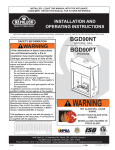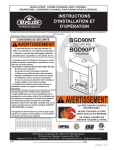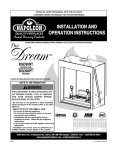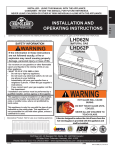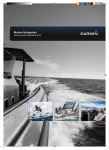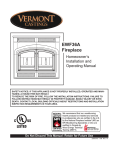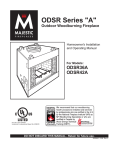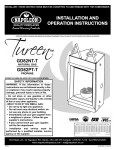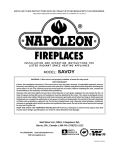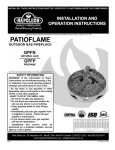Download Napoleon Fireplaces BGD90NT User's Manual
Transcript
1 INSTALLER: THESE INSTRUCTIONS MUST BE CONVEYED TO AND REMAIN WITH THE HOMEOWNER. INSTALLATION AND OPERATION INSTRUCTIONS CERTIFIED UNDER CANADIAN AND AMERICAN NATIONAL STANDARDS: CSA 2.22, ANSI Z21.50 FOR VENTED GAS FIREPLACES. BGD90NT NATURAL GAS BGD90PT PROPANE CERTIFIED FOR CANADA AND UNITED STATES USING ANSI/CSA METHODS. SAFETY INFORMATION WARNING: If the information in these instructions are not followed exactly, a fire or explosion may result causing property damage, personal injury or loss of life. - Do not store or use gasoline or other flammable vapors and liquids in the vicinity of this or any other appliance. - WHAT TO DO IF YOU SMELL GAS: Do not try to light any appliance. Do not touch any electrical switch; do not use any phone in your building. Immediately call your gas supplier from a neighbour’s phone. Follow the gas supplier’s instructions. If you cannot reach your gas supplier, call the fire department. - Installation and service must be performed by a qualified installer, service agency or the supplier. Wolf Steel Ltd., 24 Napoleon Rd., Barrie, ON L4M 4Y8 Canada • (705)721-1212 • fax(705)722-6031 W415-0614 / A / 07.24.07 www.napoleonfireplaces.com • [email protected] $10.00 W415-0614 / A / 07.24.07 2 TABLE of CONTENTS PG2-5 20-24 INTRODUCTION Warnings and Safety Precautions Warranty Dimensions General Instructions General Information Care of Glass & Plated Parts 5-9 Fireplace Operation Hand Held Remote Operation Temperature Display Room Thermostat SMART Thermostat Flame Height Fan Shield Child Proof Function Remote Auxiliary Outlet Low Battery / Manual Bypass Operating Instructions Maintenance VENTING Vent lengths Venting Specifications Air Terminal Locations 10-14 INSTALLATION/FRAMING Wall & Ceiling Protection Using Flexible Vent Components Fireplace Vent Connection Gas Installation Restricting Vertical Vents Framing Clearance to Combustibles Mantle Clearances and Enclosures 14 24 25-26 REPLACEMENTS Ordering Replacement Parts Replacement Parts Terminal Kits Vent Kits Accessories ELECTRICAL CONNECTION FINISHING Door Removal Log Shipping Bracket Removal Brick Panel Installation Andiron Placement Log Placement Charcoal Embers Night Light Replacement 19 ADJUSTMENTS Pilot Burner Adjustment Venturi Adjustment Air Control Rod Access Schematic 15-18 OPERATION / MAINTENANCE 27-28 TROUBLE SHOOTING GUIDE 29 SERVICE HISTORY 30 NOTES REMOTE AND VALVE ACCESS Remote Removal Valve Removal PLEASE RETAIN THIS MANUAL FOR FUTURE REFERENCE WARNING • Do not burn wood or other materials in this fireplace. • Adults and especially children should be alerted to the hazards of high surface temperatures and should stay away to avoid burns or clothing ignition. Supervise young children when they are in the same room as the fireplace. • Ensure you have incorporated adequate safety measure to protect infants/toddlers from touching hot surfaces. • Due to high temperatures, the fireplace should be located out of traffic and away from furniture and draperies. • Clothing or other flammable material should not be placed on or near the fireplace. • Check with your local hearth specialty dealer for safety screens and hearth guards to protect children from hot surfaces. These screens and guards must be fastened to the floor. • Any safety screen or guard removed for servicing must be replaced prior to operating the fireplace. • Even after the fireplace is out, the glass and/or screen will remain hot for an extended period of time. • It is imperative that the control compartments, burners and circulating blower and its passageway in the fireplace and venting system are kept clean. The fireplace and its venting system should be inspected before use and at least annually by a qualified service person. More frequent cleaning may be required due to excessive lint from carpeting, bedding material, etc. The fireplace area must be kept clear and free from combustible materials, gasoline and other flammable vapours and liquids. • Under no circumstances should this fireplace be modified. • This fireplace must not be connected to a chimney flue pipe serving a separate solid fuel burning appliance. • Do not use this fireplace if any part has been under water. Immediately call a qualified service technician to inspect the fireplace and to replace any part of the control system and any gas control which has been under water. • Do not operate the fireplace with the glass door removed, cracked or broken. Replacement of the glass should be done by a licensed or qualified service person. • Do not strike or slam shut the fireplace glass door. • This fireplace uses and requires a fast acting thermocouple. Replace only with a fast acting thermocouple supplied by Wolf Steel Ltd. • Only doors/optional fronts certified with the appliance shall be used. • Pressure relief doors must be kept closed while the fireplace is operating to prevent exhaust fumes containing carbon monoxide, from entering into the home. Temperatures of the exhaust escaping through these openings can also cause the surrounding combustible materials to overheat and catch fire. W415-0614 / A / 07.24.07 3 NAPOLEON® products are manufactured under the strict Standard of the world recognized ISO 9001 : 2000 Quality Assurance Certificate. NAPOLEON® products are designed with superior components and materials, assembled by trained craftsmen who take great pride in their work. The burner and valve assembly are leak and test-fired at a quality test station. The complete fireplace is thoroughly inspected by a qualified technician before packaging to ensure that you, the customer, receives the quality product that you expect from NAPOLEON®. NAPOLEON® GAS FIREPLACE PRESIDENT’S LIFETIME LIMITED WARRANTY The following materials and workmanship in your new NAPOLEON® gas fireplace are warranted against defects for as long as you own the fireplace. This covers: combustion chamber, heat exchanger, stainless steel burner, PHAZER™ logs and embers, ceramic glass (thermal breakage only), gold plated parts against tarnishing, porcelainized enamelled components and aluminum extrusion trims. Electrical (110V and millivolt) components and wearable parts such as the blower, gas valve, thermal switch, switches, wiring, remote control, ignitor, gasket, and pilot assembly are covered and NAPOLEON® will provide replacement parts free of charge during the first year of the limited warranty. Light bulbs are not covered by this warranty. Labour related to warranty repair is covered free of charge during the first year. Repair work, however, requires the prior approval of an authorized company official. Labour costs to the account of NAPOLEON® are based on a predetermined rate schedule and any repair work must be done through an authorized NAPOLEON® dealer. CONDITIONS AND LIMITATIONS NAPOLEON® warrants its products against manufacturing defects to the original purchaser only -- i.e., the individual or legal entity (registered customer) whose name appears on the warranty registration card filed with NAPOLEON® -- provided that the purchase was made through an authorized NAPOLEON® dealer and is subject to the following conditions and limitations: This factory warranty is nontransferable and may not be extended whatsoever by any of our representatives. The gas fireplace must be installed by a licensed, authorized service technician or contractor. Installation must be done in accordance with the installation instructions included with the product and all local and national building and fire codes. This limited warranty does not cover damages caused by misuse, lack of maintenance, accident, alterations, abuse or neglect and parts installed from other manufacturers will nullify this warranty. This limited warranty further does not cover any scratches, dents, corrosion or discolouring caused by excessive heat, abrasive and chemical cleaners nor chipping on porcelain enamel parts, mechanical breakage of PHAZER™ logs and embers, nor any venting components used in the installation of the fireplace. NAPOLEON® warrants its stainless steel burners against defects in workmanship and material for life, subject to the following conditions: During the first 10 years NAPOLEON® will replace or repair the defective parts at our option free of charge. From 10 years to life, NAPOLEON® will provide replacement burners at 50% of the current retail price. In the first year only, this warranty extends to the repair or replacement of warranted parts which are defective in material or workmanship provided that the product has been operated in accordance with the operation instructions and under normal conditions. After the first year, with respect to this President’s Limited Lifetime Warranty, NAPOLEON® may, at its discretion, fully discharge all obligations with respect to this warranty by refunding to the original warranted purchaser the wholesale price of any warranted but defective part(s). After the first year, NAPOLEON® will not be responsible for installation, labour or any other costs or expenses related to the reinstallation of a warranted part, and such expenses are not covered by this warranty. Notwithstanding any provisions contained in this President’s Limited Lifetime Warranty, NAPOLEON®’S responsibility under this warranty is defined as above and it shall not in any event extend to any incidental, consequential or indirect damages. This warranty defines the obligations and liability of NAPOLEON® with respect to the NAPOLEON® gas fireplace and any other warranties expressed or implied with respect to this product, its components or accessories are excluded. NAPOLEON® neither assumes, nor authorizes any third party to assume, on its behalf, any other liabilities with respect to the sale of this product. NAPOLEON® will not be responsible for: over-firing, downdrafts, spillage caused by environmental conditions such as rooftops, buildings, nearby trees, hills, mountains, inadequate vents or ventilation, excessive venting configurations, insufficient makeup air, or negative air pressures which may or may not be caused by mechanical systems such as exhaust fans, furnaces, clothes dryers, etc. Any damages to fireplace, combustion chamber, heat exchanger, brass trim or other component due to water, weather damage, long periods of dampness, condensation, damaging chemicals or cleaners will not be the responsibility of NAPOLEON®. The bill of sale or copy will be required together with a serial number and a model number when making any warranty claims from your authorized dealer. The warranty registration card must be returned within fourteen days to register the warranty. NAPOLEON® reserves the right to have its representative inspect any product or part thereof prior to honouring any warranty claim. ALL SPECIFICATIONS AND DESIGNS ARE SUBJECT TO CHANGE WITHOUT PRIOR NOTICE DUE TO ON-GOING PRODUCT IMPROVEMENTS. NAPOLEON®® IS A REGISTERED TRADEMARK OF WOLF STEEL LTD. PATENTS U.S. 5.303.693.801 - CAN. 2.073.411, 2.082.915. © WOLF STEEL LTD. W415-0614 / A / 07.24.07 4 FIGURE 1 6" GENERAL INSTRUCTIONS THIS GAS FIREPLACE SHOULD BE INSTALLED AND SERVICED BY A QUALIFIED INSTALLER to conform with local codes. Installation practices vary from region to region and it is important to know the specifics that apply to your area, for example: in Massachusetts State: • The fireplace damper must be removed or welded in the open position prior to installation of a fireplace insert or gas log. • The appliance off valve must be a “T” handle gas cock. • The flexible connector must not be longer than 36 inches. • A Carbon Monoxide detector is required in all rooms containing gas fired appliances. • The appliance is not approved for installation in a bedroom or bathroom unless the unit is a direct vent sealed combustion product. • WARNING: This product must be installed by a licensed plumber or gas fitter when installed within the commonwealth of Massachusetts. In absence of local codes, install to the current CAN/CGA -B149 Installation Code in Canada or to the National Fuel Gas Code, ANSI Z223.1, and NFPA 54 in the United States. Suitable for mobile home installation if installed in accordance with the current standard CAN/CSA Z240MH Series, for gas equipped mobile homes, in Canada or ANSI Z223.1 and NFPA 54 in the United States. The fireplace and its individual shutoff valve must be disconnected from the gas supply piping system during any pressure testing of that system at test pressures in excess of 1/2 psig (3.5 kPa). The fireplace must be isolated from the gas supply piping system by closing its individual manual shutoff valve during any pressure testing of the gas supply piping system at test pressures equal to or less than 1/2 psig (3.5 kPa). When the fireplace is installed directly on carpeting, vinyl tile or other combustible material other than wood flooring, the fireplace shall be installed on a metal or wood panel extending the full width and depth. The optional heat circulating blower is supplied with a cord. If installed, the junction box must be electrically connected and grounded in accordance with local codes. In the absence of local codes, use the current CSA C22.1 CANADIAN ELECTRICAL CODE in Canada or the ANSI/NFPA 70 NATIONAL ELECTRICAL CODE in the United States. Purge all gas lines with the glass door of the fireplace open. Assure that a continuous gas flow is at the burner before closing the door. Under extreme vent configurations, allow several minutes (5-15) for the flame to stabilize after ignition. W415-0614 / A / 07.24.07 Provide adequate ventilation and combustion air. Provide adequate accessibility clearance for servicing and operating the fireplace. Never obstruct the front opening of the fireplace. Objects placed in front of the fireplace must be kept a minimum of 48” from the front face of the unit. Minimum clearance to combustible construction from fireplace and vent surfaces: fireplace framing 0” to stand-offs (top, rear and sides) fireplace finishing - 4 3/4” to sides, firebox opening. 21” to top of fireplace opening. vent pipe - 2 inches recessed depth - 29 inches GENERAL INFORMATION FOR YOUR SATISFACTION, THIS FIREPLACE HAS BEEN TEST-FIRED TO ASSURE ITS OPERATION AND QUALITY! Maximum input is 50,000 BTU/hr for both natural gas and propane. When the fireplace is installed at elevations above 4,500ft, and in the absence of specific recommendations from the local authority having jurisdiction, the certified high altitude input rating shall be reduced at the rate of 4% for each additional 1,000ft. Maximum output for natural gas is 33,540 BTU/hr at an efficiency of 63%; and 34,000 BTU/hr for propane at an efficiency of 61%. Minimum inlet gas supply pressure is 4.5 inches water column for natural gas and 11 inches water column for propane. Maximum inlet gas pressure is 7 inches water column for natural gas and 13 inches water column for propane. Manifold pressure under flow conditions is 3.5 inches water column for natural gas and 10 inches water column for propane. This fireplace is approved for bathroom, bedroom and bedsitting room installations and is certified for mobile home installation. The natural gas model can only be installed in a mobile home that is permanently positioned on its site and fueled with natural gas. This fireplace is only for use with the type of gas indicated on the rating plate. This fireplace is not convertible for use with other gases, unless a certified kit is used. No external electricity (110 volts or 24 volts) is required for the gas system operation. Expansion / contraction noises during heating up and cooling down cycles are normal and are to be expected. Change in flame appearance from “HI” to “LO” is more evident in natural gas than in propane. 5 CARE OF GLASS, AND PLATED PARTS We Suggest that our gas hearth products be installed and serviced by professionals who are certified in the U.S. by the National Fireplace Institute (NFI) as NFI Gas Specialists. Do not use abrasive cleaners to clean glass. Buff lightly with a clean dry cloth. The glass is 3/16” tempered glass available from your NAPOLEON® / Wolf Steel Ltd. dealer. DO NOT SUBSTITUTE MATERIALS. Clean the glass after the first 10 hours of operation with a recommended gas fireplace glass cleaner. Thereafter clean as required. DO NOT CLEAN GLASS WHEN HOT! If the glass is not kept clean permanent discolouration and / or blemishes may result. VENTING Note: If for any reason the vent air intake system is disassembled; reinstall per the instructions provided for the initial installations. VENTING LENGTHS & AIR TERMINAL LOCATIONS FIGURES 2A-B 16" 24" 12" For safe and proper operation of the fireplace follow the venting instuction exactly. Deviation from the minimum vertical vent length can create difficulty in burner start-up and/or carboning. Provide a means for visually checking the vent connection to the fireplace after the fireplace is installed. Vent lengths that pass through unheated spaces (attics, garages, crawl spaces) should be insulated with the insulation wrapped in a protective sleeve to minimize condensation. When using NAPOLEON® venting components, use only approved Wolf Steel Ltd. flexible vent components with the following termination kits: WALL TERMINAL KIT GD622, or 1/12 TO 7/12 PITCH ROOF TERMINAL KIT GD610, 8/12 TO 12/12 ROOF TERMINAL KIT GD611, FLAT ROOF TERMINAL KIT GD612. With flexible venting, in conjunction with the various terminations, use either the 5 foot vent kit GD620 or the 10 foot vent kit GD630. These vent kits allow for either horizontal or vertical venting of the fireplace. The maximum allowable vertical vent length is 40 feet. The maximum number of allowable 8” vent connections is three horizontally or vertically (excluding the fireplace and the air terminal connections). For optimum flame appearance and fireplace performance, keep the vent length and number of elbows to a minimum. The air terminal must remain unobstructed at all times. Examine the air terminal at least once a year to verify that it is unobstructed and undamaged. When venting, the horizontal run must be kept to a minimum of 16 inches or a maximum of 20 feet. If a 20 foot horizontal run is required, the fireplace must have a minimum vertical rise immediately off the fireplace of 57 inches. FIGURES 2a-c. When terminating vertically, the vertical rise is a minimum 34 inches and a maximum 40 feet above the fireplace. FIGURE 3. FIGURE 3 For optimum performance, it is recommended that all horizontal runs have a minimum ¼ inch rise per foot. Provide a means for visually checking the vent connection to the fireplace after the fireplace is installed. Do not allow the inside liner to bunch up on horizontal or vertical runs and elbows. Keep it pulled tight. A 3/4” air gap between the inner and outer liner all around is required for safe operation. Use a firestop when penetrating interior walls, floor or ceiling. For safe and proper operation of the fireplace follow the venting instruction exactly. If vertical rises greater than 57 inches are necessary, the increased rise must be deducted from the horizontal run. W415-0614 / A / 07.24.07 6 ELBOW VENT LENGTH VALUES DEFINITIONS for the following symbols used in the venting calculations and examples are: > - greater than > - equal to or greater than < - less than < - equal to or less than HT - total of both horizontal vent lengths (HR) and offsets (HO) in feet HR - combined horizontal vent lengths in feet HO - offset factor: .03 (total degrees of offset - 90°*) in feet VT - combined vertical vent lengths in feet 1° 15° 30° 45° 90°* feet 0.03 0.45 0.9 1.35 2.7 inches 0.5 6.0 11.0 16.0 32.0 * the first 90° offset has a zero value and is shown in the formula as -90° TOP EXIT / HORIZONTAL TERMINATION When (HT) < (VT ) Simple venting configuration (only one 90° elbow) Simple venting configuration (only one 90° elbow) See graph to determine the required vertical rise VT for the required horizontal run HT. For vent configurations requiring more than one 90° elbow, the following formulas apply: Formula 1: HT < VT Formula 2: HT + VT < 40 feet FIGURE 4 90° Example 1: H2 V2 FIGURE 5 90° H1 90° V1 VERTICAL RISE IN FEET VT HORIZONTAL VENT RUN PLUS OFFSET IN FEET HT The shaded area within the lines represents acceptable values for HT and VT . V1 V2 VT H1 H2 HR HO ft HT = = = = = = = 3 ft 8 ft V1 + V2 = 3 + 8 = 11 ft 2.5 ft 2 ft H1 + H2 = 2.5 + 2 = 4.5 ft .03 (three 90° elbows - 90°) = .03(270° - 90°) = 5.4 = HR + HO = 4.5 + 5.4 = 9.9 ft HT + VT = 9.9 + 11 = 20.9 ft Formula 1: W415-0614 / A / 07.24.07 H T < VT 9.9 < 11 Formula 2: HT + VT < 40 feet 20.9 < 40 Since both formulas are met, this vent configuration is acceptable. 7 TOP EXIT / HORIZONTAL TERMINATION when (HT) > (VT) Simple venting configuration (only one 90° elbow) ceptable. 90° H4 H1 FIGURE 6 H2 See graph to determine the required vertical rise VT for the required horizontal run HT. V1 90° V2 H3 FIGURE 8 Example 3: V1 V2 VT H1 H2 H3 H4 HR HO ft HT HT + V T REQUIRED VERTICAL RISE IN INCHES VT = = = = = = = = = 4 ft 1.5 ft V1 + V2 = 4 + 1.5 = 5.5 ft 2 ft 1 ft 1 ft 1.5 ft H1 + H2 + H3 + H4 = 2 + 1 + 1 + 1. 5 = 5.5 ft .03 (four 90° elbows - 90°) = .03(360° - 90°) = 8.1 = HR + HO = 5.5 + 8.1 = 13.6 ft = 13.6 + 5.5 = 19.1 ft HORIZONTAL VENT RUN PLUS OFFSET IN FEET HT The shaded area within the lines represents acceptable Formula 1: HT < 4.2 VT values for HT and VT . 4.2 VT = 4.2 x 5.5 = 23.1 ft For vent configurations requiring more than one 90° elbow the 13.6 < 23.1 following formulas apply: Formula 2: HT + VT < 24.75 feet Formula 1: HT < 4.2 VT Formula 2: HT + VT < 24.75 feet 19.1 < 24.75 Since both formulas are met, this vent configuration is acceptable. H1 Example 2: H2 V1 90° FIGURE 7 V1 = = H1 = H2 = HR = HO ft HT = HT + VT= VT = 6 ft 3 ft 5 ft H1 + H2 = 3 + 5 = 8 ft .03 (two 90° elbows - 90°) = .03(180° - 90°) = 2.7 HR + HO = 8 + 2.7 = 10.7 ft 10.7 + 6 =16.7 Formula 1: HT < 4.2 VT Formula 2: 10.7 < 25.2 HT + VT < 24.75 feet 16.7 < 24.75 4.2 VT = 4.2 x 6 = 25.2 ft Since both formulas are met, this vent configuration is ac- W415-0614 / A / 07.24.07 8 TOP EXIT VERTICAL TERMINATION when (HT) < (VT) REQUIRED VERTICAL RISE IN FEET VT FIGURE 9 Simple venting configurations See graph to determine the required vertical rise VT for the required horizontal run HT. HORIZONTAL VENT RUN PLUS OFFSET IN FEET HT The shaded area within the lines represents acceptable values for HT and VT . For vent configurations requiring more than zero 90° elbow (top exit) or one 90° elbow (rear exit), the following formulas apply: Formula 1: HT < VT Formula 2: HT + VT < 40 feet TOP VERTICAL TERMINATION when (HT) > (VT) Simple venting configurations Formula 1: HT < 3VT Formula 2: HT + VT < 40 feet Example 7: FIGURE 10 V1 V2 V3 = 2 ft = 1 ft = 1.5 ft FIGURE 11 See graph to determine the required vertical rise VT for the required horizontal run HT. For vent configurations requiring more than two 90° elbow (top exit) or one 90° elbow (rear exit), the following formulas apply: MAXIMUM VERTICAL RISE IN FEET VT HORIZONTAL VENT RUN PLUS OFFSET IN FEET HT The shaded area within the lines represents acceptable values for HT and VT . W415-0614 / A / 07.24.07 VT H1 H2 HR HO = V1 + V2 + V3 = 2 + 1 + 1.5 = 4.5 ft = 6 ft = 2 ft = H1 + H2 = 6 + 2 = 8 ft = .03 (four 90° elbows - 90°) = .03(90 + 90 + 90 + 90 - 90) = 8.1 ft HT = HR + HO = 8 + 8.1 = 16.1 ft HT + VT = 16.1 + 4.5 = 20.6 ft Formula 1: HT < 3VT 3VT = 3 x 4.5 = 13.5 ft 16.1 > 13.5 Since this formula is not met, this vent configuration is unacceptable. Formula 2: HT + VT < 40 feet 20.6 < 40 Since only formula 2 is met, this vent configuration is unacceptable and a new fireplace location or vent configuration will need to be established to satisfy both formulas. 9 AIR TERMINAL INSTALLATIONS FIGURE 12 INSTALLATIONS CANADIAN U.S.A. A 12 INCHES 12 INCHES Clearance above grade, veranda porch, deck or balcony. B 12 INCHES 9 INCHES Clearance to windows or doors that open. C 12 INCHES* 12 INCHES* Clearance to permanently closed windows. D 18 INCHES** 18 INCHES** Vertical clearance to ventilated soffit located above the terminal within a horizontal distance of 2 feet from the centerline of the terminal. E 12 INCHES** 12 INCHES** Clearance to unventilated soffit. F 0 INCHES 0 INCHES 0 INCHES*** 0 INCHES*** Clearance to an inside non-combustible corner wall or protruding non-combustible obstructions (chimney, etc.). 2 INCHES*** 2 INCHES*** Clearance to an inside combustible corner wall or protruding combustible obstructions ( vent chase, etc.). H 3 FEET 3 FEET**** Clearance to each side of the centerline extended above the meter / regulator assembly to a maximum vertical distance of 15ft. I 3 FEET 3 FEET**** Clearance to a service regulator vent outlet. J 12 INCHES 9 INCHES Clearance to a non-mechanical air supply inlet to the building or a combustion air inlet to any other appliance. K 6 FEET 3 FEET† L 7 FEET‡ 7 FEET**** M 12 INCHES†† 12 INCHES**** N 16 INCHES 16 INCHES O 2 FEET†* 2 FEET†* G * ** *** **** † ‡ †† †* Clearance to an outside corner wall. Clearance to a mechanical air supply inlet. Clearance above a paved sidewalk or paved driveway located on public property unless fitted with a heat shield kit GD-301. Clearance under a veranda, porch, deck or balcony. Clearance above the roof. Clearance from an adjacent wall including neighbouring buildings. Recommended to prevent condensation on windows and thermal breakage It is recommended to use a heat shield and to maximize the distance to vinyl clad soffits. The periscope GD-401 requires a minimum 18 inches clearance from an inside corner. This is a recommended distance. For additional requirements check local codes. Three feet above if within 10 feet horizontally. A vent shall not terminate directly above a sidewalk or paved driveway that is located between two single family dwellings and serves both dwellings. Permitted only if the veranda, porch, or deck is fully open on a minimum of two sides beneath the floor. Recommenced to prevent recirculation of exhaust products. For additional requirements check local codes. W415-0614 / A / 07.24.07 10 INSTALLATION WALL AND CEILING PROTECTION For optimum performance it is recommended that all horizontal runs have a minimum of 1/4” rise per foot using flexible venting. For safe and proper operation of the fireplace, follow the venting instructions exactly. HORIZONTAL TERMINATION: A clearance to combustibles of 2” must be maintained when penetrating combustible walls. The firestop spacer (W615-0075) supplied with the unit should be used to maintain this clearance. HORIZONTAL INSTALLATION This application occurs when venting FIGURE 13 through an exterior wall. Having determined the air terminal location, cut and frame a hole in an 14 1/2 14 1/2 exterior wall. The recommended framed opening is 141/2” W x 141/2” H with a minimum 141/2” 14 1/2 round or square opening inside a finished wall. See figure15. 1. Mark and cut the vent pipe shield to the determined depth of the combustible wall. Apply a bead of caulking (not supplied) to the framework or to the shield plate (in the case of a finished wall) and secure the shield through the opening to the interior wall. The final location of the vent pipe shield should maintain the required clearance to the 10” vent pipe / liner. (See note above). Do not fill this cavity with any type of material. Apply a bead of caulking around the firestop spacer then along the edge of the vent shield to restrict cold air from being drawn into the room or around the fireplace. Ensure that both spacer and shield maintain the required clearance to combustibles. Once the vent pipe / liner is installed in its final position, apply sealant between the pipe / liner and the firestop spacer. OR FIGURE 14 VERTICAL INSTALLATION This application occurs when venting through a roof. Installation kits for various roof pitches are available from your NAPOLEON® dealer. See Accessories to order the specific kit required. FIGURE 15 141/2 1 14 /2 FIRESTOP UNDERSIDE OF JOIST 1. Determine the air terminal location, cut and frame 141/2” W x 141/2” H openings in the ceiling and the roof to provide the minimum 2 inch clearance between the fireplace pipe / liner and any combustible material. Try to centre the exhaust pipe location midway between two joist to prevent having to cut them. Use a plumb bob to line up the centre of the openings. DO NOT FILL THIS SPACE WITH ANY TYPE OF MATERIAL. FIGURE 16 A vent pipe shield will prevent any materials such as insulation, from filling up the 1” air space CAULKING around the pipe. Nail VENT PIPE headers between the SHIELD joist for extra support. 2. Apply a bead of caulking (not supplied) to the framework or to the Wolf Steel vent pipe shield plate or equivalent (in the case of a finished ceiling), and secure over the opening in the ceiling. A firestop must be placed on the bottom of each framed opening in a roof or ceiling that the venting system passes through. Apply a bead of caulking all around and place a firestop spacer over the vent shield to restrict cold air from being drawn into the room or around the fireplace. Ensure that both spacer and shield maintain the required clearance to combustibles. Once the vent pipe / liner is installed in its final position, apply sealant between the pipe / liner and the firestop spacer. 3. In the attic, after the pipe / liner has been installed, slide the vent pipe collar down to cover up the open end of the shield and tighten. This will prevent any materials, such as insulation, from filling up the 1” air space around the pipe. VENT PIPE SHIELD CAULKING FIRESTOP SPACER #8x1/2” Self Drilling Screws 2” Overlap Hi-Temp Sealant SHOWN FROM INSIDE THE STRUCTURE W415-0614 / A / 07.24.07 FIGURE 17 11 USING FLEXIBLE VENT COMPONENTS Use only approved aluminum flexible liner kits marked: 7. Using the 10” diameter flexible aluminium liner, apply sealant, slide a minimum of 2” over the fireplace combustion air collar and secure with 6 #8 screws. VERTICAL AIR TERMINAL INSTALLATION “Wolf Steel Approved Venting” as identified by the stamp only on the 10” outer liner. For safe and proper operation of the fireplace, follow the venting instructions exactly. All inner exhaust and outer intake vent pipe joists may be sealed using either Red RTV high temp silicone sealant or Black high temp Mill Pac with the exception of the fireplace exhaust flue collar which must be sealed using Mill Pac (not supplied). HORIZONTAL AIR TERMINAL INSTALLATION Note: Direct vent terminals shall not be recessed into a wall or siding. 1. Cut or frame a hole in an exterior wall with a minimum round or square opening of 141/2” W x 141/2” H. Secure the firestop spacer over the opening to the interior wall. 2. Stretch the 8” diameter flexible aluminum liner to the required length taking into account the additional length needed for the finished wall surface. Slip the liner a minimum of 2” over the inner sleeve of the air terminal and secure with 6 #8 screws. Apply a heavy bead of the high temperature sealant (W573-0007 not provided). 3. Using the 10” diameter flexible aluminum liner, slide over the outer combustion air sleeve of the air terminal and secure with 6 #8 screws. Seal as before. #10x2½" SCREWS FIGURE 18 CAULKING 8"FLEX PIPE 2" OVERLAP 10" FLEX PIPE HI-TEMP SEALANT TERMINAL EXTENSION PLATE FIGURE 19 8 10 10 10 8 4. Insert the liners through the firestop maintaining the required clearance to combustibles. Secure to the exterior wall and make weather tight by sealing with caulking (not supplied). 5. Apply a heavy bead of the high temperature sealant, not supplied with the unit, to the inside of the 8” liner approximately 1” from the end. Slip the liner a minimum of 2” over the fireplace vent collar and secure with 6 #8 screws. 6. If more than one liner is run we recommend supporting every 5ft. 1. Move the fireplace into position. Figure 20 2. Fasten the roof support to the roof using the screws provided. The roof support is optional. In this case the venting is to be adequately supported using either an alternate method suitable to the authority having j
































